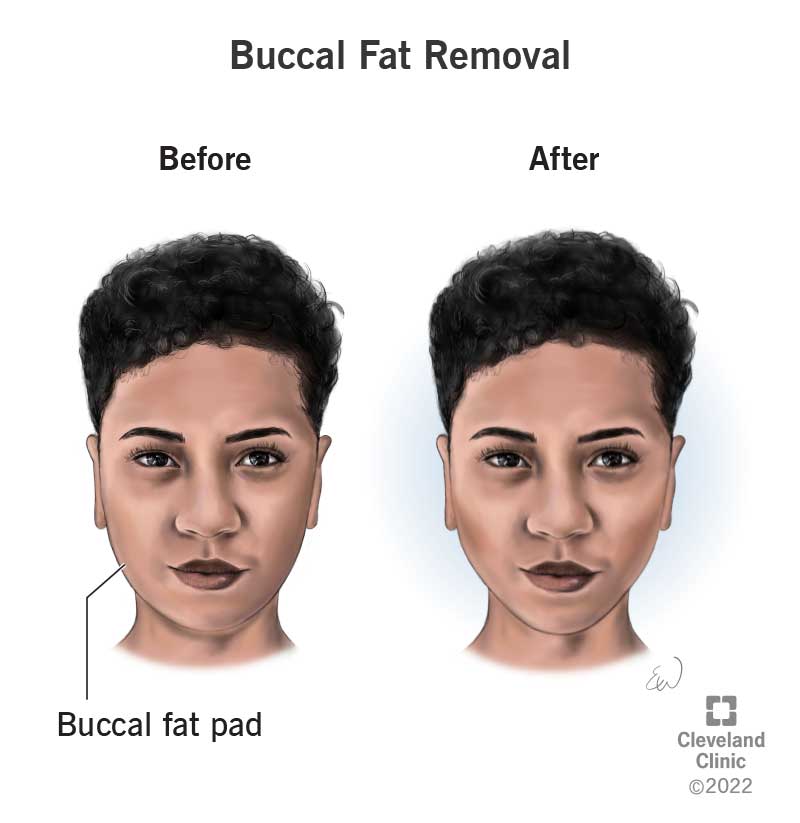Buccal fat is fat between your cheekbones and jaw bones in your face. These fat pads help make up the shape of your face. Buccal fat removal is a surgery to remove the fat in this area of your face. This can highlight the bone structure in your face, especially your cheekbones and the hollowed-out areas between your cheeks and jawline. The procedure is also sometimes called a cheek reduction.
Advertisement
Cleveland Clinic is a non-profit academic medical center. Advertising on our site helps support our mission. We do not endorse non-Cleveland Clinic products or services. Policy

Buccal fat is the fat between your cheekbones and jaw bones that help make up the shape of your face. Everyone has buccal fat, but some people have more than others.
Advertisement
Cleveland Clinic is a non-profit academic medical center. Advertising on our site helps support our mission. We do not endorse non-Cleveland Clinic products or services. Policy
Buccal fat removal is a surgery to remove the fat in this area of your face. Removing this fat can highlight the bone structure in your face, especially your cheekbones and the hollowed-out areas between your cheeks and jawline. This procedure is also sometimes called a cheek reduction.
Buccal fat removal surgery is a type of plastic surgery. The decision to have plastic surgery is a personal one. It’s best to consider plastic surgery only if you truly desire to modify your appearance and not because someone else wants you to. It’s also important to consider the possible benefits and risks of having plastic surgery.
Some people may feel the roundness in their cheeks creates a fullness to their face they don’t like. Having a cheek reduction can alleviate the sense of fullness or “chubbiness” of your cheeks.
You may consider having this procedure if you:
You may not be a good candidate for buccal fat removal if your face is narrow or if you’re over a certain age, as buccal fat naturally diminishes with age.
Buccal fat removal surgery is usually performed by a healthcare provider with special training in plastic surgery procedures such as a licensed plastic surgeon.
Advertisement
Before buccal fat removal surgery, you’ll meet with your healthcare provider. They’ll discuss with you what you’d like to achieve from surgery, as well as what to expect during and after your procedure.
During your initial visit, your provider will examine you and likely take photographs of your face. They’ll also ask you general questions about your overall health, such as your family health history and any past surgeries you’ve had. They’ll take basic health information such as your blood pressure and discuss any current medications you take. It’s important for you to tell your provider about all of your medications, including herbs and supplements. For best outcomes, they may want you to stop smoking or using tobacco products prior to surgery.
During this time, your healthcare provider will address any questions you have and explain what to expect during the surgery. They can provide recommendations tailored to your specific goals and discuss any risks for the procedure.
Buccal fat removal can be done in a hospital or in your healthcare provider’s office, and you’ll go home the same day.
During your procedure, you can expect the following:
After your procedure, your healthcare provider will explain how to care for your incisions. They may give you a special mouth rinse to help with healing and prevent infection. You’ll be on a liquid diet for a day or two while your incisions start to heal. Gradually, you can add soft foods to your diet as your provider says it’s OK.
Some things you can expect after surgery:
These should gradually fade as your body heals. Healing time is usually about three weeks. It will take time — usually several months — before you’ll see the final results.
With any surgery, you must weigh the risks and the potential benefits of having the procedure. Your healthcare provider will discuss with you any risks so you can make an informed decision.
Some risks associated with buccal fat removal surgery are:
After your procedure, your provider will give you instructions on what to do to promote healing. It’s important to follow your provider’s after-care instructions, including any follow-up appointments. Healing time after this procedure is usually about three weeks, but it will take several months to see the final results.
Advertisement
You can return to normal activities when your provider says it’s OK — usually after a few days to a week.
Buccal fat removal is generally a safe procedure. But if you experience any of the following, you should call your healthcare provider right away:
It’s rare, but if you experience any of the following, call your healthcare provider or 911 right away:
The decision to have plastic surgery is an extremely personal one. You should weigh the benefits and the risks of having buccal fat removal surgery to make sure it’s right for you. But if you have round cheeks and don’t like the way they look, you may be a good candidate for buccal fat removal surgery. Talk to your healthcare provider about your options.
Advertisement
Whether you need cosmetic or reconstructive plastic surgery, you’ll need skilled, detailed and compassionate providers. At Cleveland Clinic, we’re here to help.

Last reviewed on 06/17/2022.
Learn more about the Health Library and our editorial process.